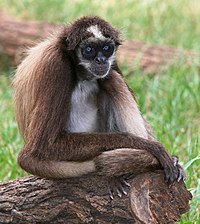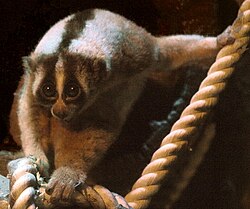The Primates Portal A primate is a member of the biological order Primates, the group that contains lemurs, the aye-aye, lorisids, galagos, tarsiers, monkeys, and apes, with the last category including great apes. With the exception of humans, who inhabit every continent on Earth, most primates live in tropical or subtropical regions of the Americas, Africa and Asia. Primates range in size from the 30-gram (1 oz) pygmy mouse lemur to the 200-kilogram (440 lb) mountain gorilla. According to fossil evidence, the primitive ancestors of primates may have existed in the late Cretaceous period around 65 mya (million years ago), and the oldest known primate is the Late Paleocene Plesiadapis, c. 55–58 mya. Molecular clock studies suggest that the primate branch may be even older, originating in the mid-Cretaceous period around 85 mya. Primates exhibit a wide range of characteristics. Some primates do not live primarily in trees, but all species possess adaptations for climbing trees. Locomotion techniques used include leaping from tree to tree, walking on two or four limbs, knuckle-walking, and swinging between branches of trees (known as brachiation). Primates are characterized by their large brains relative to other mammals. These features are most significant in monkeys and apes, and noticeably less so in lorises and lemurs. Many species are sexually dimorphic, which means males and females have different physical traits, including body mass, canine tooth size, and coloration.
Selected article
The ruffed lemurs of the genus Varecia are strepsirrhine primates and are the largest extant lemurs within the family Lemuridae. Like all living lemurs, they are found only on the island of Madagascar. Formerly considered to be a monotypic genus, two species are now recognized: the black-and-white ruffed lemur, with its three subspecies, and the red ruffed lemur.
Ruffed lemurs are diurnal and arboreal quadrupeds, often observed leaping through the upper canopy of the seasonal tropical rainforests in eastern Madagascar. They are also the most frugivorous of the Malagasy lemurs, and they are very sensitive to habitat disturbance. Ruffed lemurs live in multi-male/multi-female groups and have a complex and flexible social structure, described as fission-fusion. They are highly vocal and have loud, raucous calls. (Full article...) Selected picture The brown spider monkey, Ateles hybridus, is a species of spider monkey, a type of New World monkey, from South America. It is found in Colombia and Venezuela. Like all spider monkeys, it has very long, spindly limbs and a lengthy prehensile tail which can almost be called a fifth limb. The tail is made up of highly flexible, hairless tips with skin grooves which improves grip on tree branches and is adapted to its strictly arboreal lifestyle. It is currently critically endangered, with few examples of them remaining in the wild. CategoriesSelected species Endangered (IUCN 3.1)|Endangered The Javan slow loris (Nycticebus javanicus) is a strepsirrhine primate and a species of slow loris native to the western and central portions of the island of Java, in Indonesia. For many years, it was considered a subspecies of the Sunda slow loris (N. coucang), until the 2000s when it was promoted to full species status. It is most closely related to the Sunda slow loris and the Bengal slow loris (N. bengalensis). The species has two forms, based on hair length and, to a lesser extent, coloration. Its forehead has a prominent white diamond pattern, which is formed by a distinct stripe that runs over its head and forks towards the eyes and ears. The Javan slow loris weighs between 565–687 g (1.25–1.51 lb) and has a head-body length of about 293 mm (11.5 in). Like all lorises, it is arboreal and moves slowly across vines and lianas instead of jumping from tree to tree. Its diet typically consists of fruit, tree gum, lizards and eggs. It sleeps on exposed branches, sometimes in groups, and is usually seen alone or in pairs. The Javan slow loris population is in sharp decline due to poaching for the exotic pet trade. It is also used in research associated with traditional medicine. Remaining populations have low densities, and habitat loss is a major threat. For these reasons, the International Union for Conservation of Nature (IUCN) lists its status as "endangered," and it has also been included on the 2008–2010 list of "The World's 25 Most Endangered Primates." It is protected by Indonesian law and, since June 2007, is listed under CITES Appendix I. Despite these protections, as well as its presence in several protected areas, poaching is still incessant and the wildlife protection laws are rarely enforced at the local level. Did you know?
Primate lists
WikiProjectsThings to do
Associated WikimediaDiscover Wikipedia using portals |
© MMXXIII Rich X Search. We shall prevail. All rights reserved. Rich X Search

















